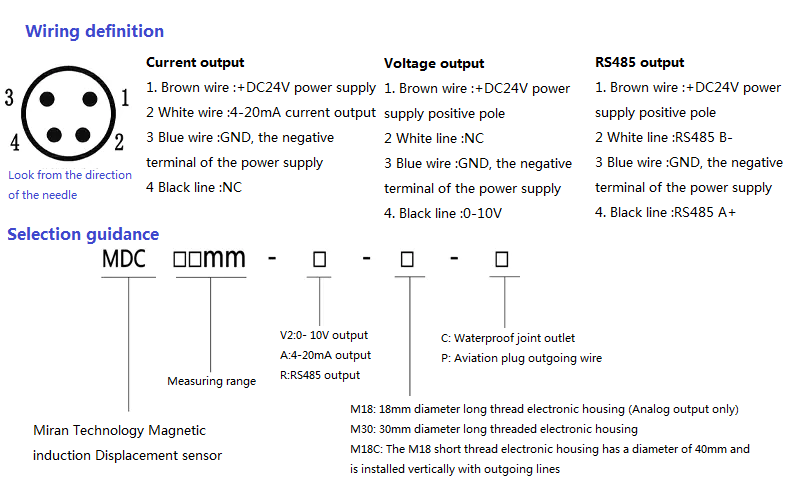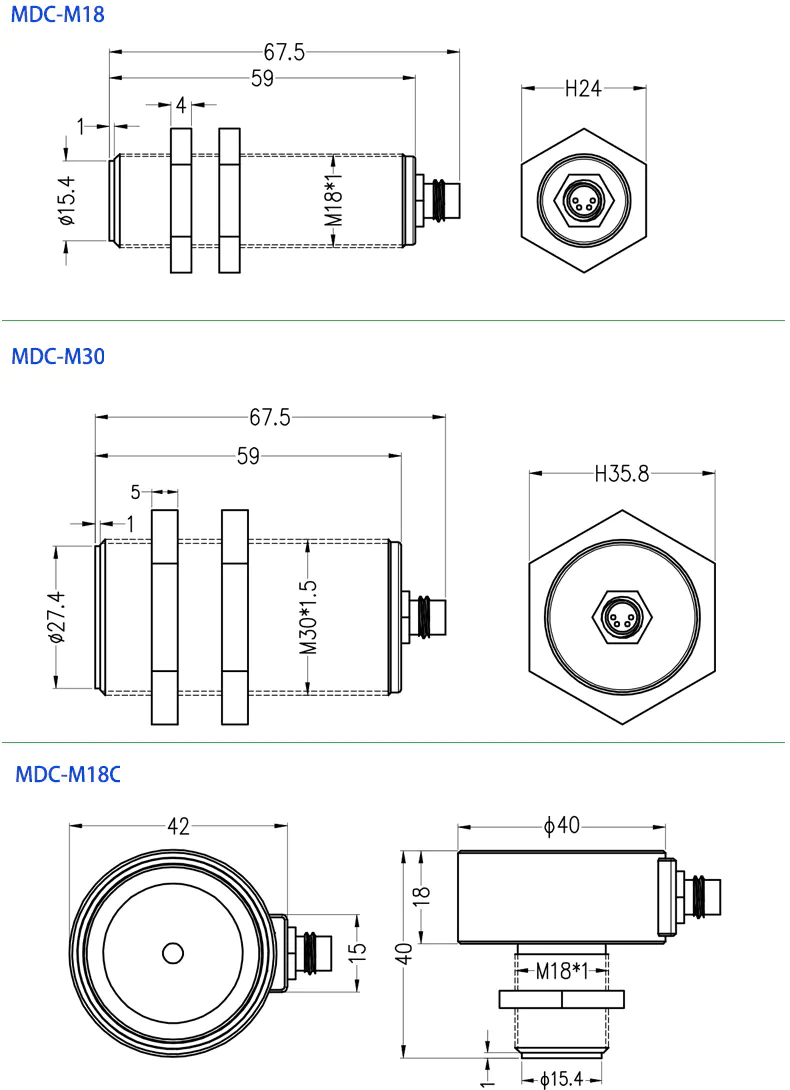I. Overview of MDC Magnetic Induction Displacement Sensor:
The MDC series magnetic induction displacement sensors can be used for non-contact displacement and distance measurement, as well as shaft and gear speed measurement, etc. Its principle is to combine the advantages of inductive sensors and magnetic sensors. A magnet is used as the detection target and fixed on the measurement object. The movement of the magnet will change the magnetic flow variation of the coil inside the sensor. Due to the mutually canceling physical effect, The strength of the signal induced by the coil will have a linear relationship with the distance of the magnet. The sensor can output a continuous linear signal by detecting the displacement change of the fixed magnet on the object being measured. The measurement range of the sensor can also be changed by altering the use of magnets of different strengths.
Magnetic induction displacement sensors have a distinct advantage in that they can detect the position of magnets through non-ferromagnetic materials such as stainless steel, aluminum, and copper. In closed systems or applications with protective housings, the sensor and the magnet can be installed separately to avoid direct contact with contamination or mechanical damage. They are suitable for environments with dust, oil stains, chemicals, and food grade.
Compared with inductive sensors, magnetic induction displacement sensors can maintain a relatively high level of sensitivity even at the end of the measurement range, making them an ideal alternative to switch elements. Users can generate any number of switch points from continuous analog signals as needed. There is no need for complex mechanical adjustments to set the switching point.
The installation methods are diverse. As this sensor can be installed through non-ferromagnetic materials, it can be immersed in a non-ferromagnetic object, installed flush with the object, or installed protruding from it without affecting the measurement accuracy.
The installation is extremely simple. The sensor does not require calibration in the linear area. Before use, just align the sensor with the magnet to set the zero point, and it can be put into use in a short time. The magnet can be installed either axially or on the side. A few millimeters of offset will not affect the characteristic curve, but a larger offset will affect the linearity and slope. Especially when the installation space is limited, lateral installation provides an alternative space-saving solution.
II. Structural Types of MDC Magnetic Induction Displacement Sensor:
Standard housing: M18/M30 stainless steel threaded housing (IP68), or flat plastic housing (lightweight installation).
Non-standard customization: Flexible design based on installation space, complex working conditions and other requirements.
This series, with its high reliability, low maintenance cost and environmental adaptability, has become the preferred solution for displacement measurement in complex industrial scenarios.
III. Application Fields of MDC Magnetic Induction Displacement Sensor:
● Industrial Automation ● Mechanical manufacturing
● Special Environment ● Closed system
IV. Technical Parameters, Wiring Definitions and Selection Guidance of MDC Magnetic Induction Displacement Sensors:
Model | MDC10mm-X-X-X | MDC20mm-X-X-X | MDC30mm-X-X-X | MDC40mm-X-X-X | MDC50mm-X-X-X |
Measuring range | 10mm | 20mm | 30mm | 40mm | 50mm |
Resolution | 0.05%FS / RS485:16bit |
Repeatability | ≤±0.05%FS |
Linearity | ≤±2%FS |
Temperature drift | ≤300ppm FSO/K |
Working voltage | 12~30VDC |
Frequency response(-3dB) | 1000Hz |
Maximum operating current | Voltage<20mA;Current <40mA;RS485<35mA |
Output mode | 0-10V/4-20mA/RS485 |
Magnet temperature | Default maximum operating temperature: 80℃ Customizable high-temperature magnets at 250℃ |
Operating temperature | -20°C~+80°C |
Storage temperature | -40°C~+85°C |
Level of protection | IP67,Other grades can be customized |
V. Installation Dimensions:
VI. Precautions:
The sensor is a magnetic sensor. The fixed components for installation and the screws used must be non-ferromagnetic.
Both ferromagnetic materials and the magnetic field existing in the sensor measurement area can affect the performance of the sensor.
When the sensor is in use, the working environment should not have strong electromagnetic interference.
Before setting the zero point adjustment of the sensor, please ensure that the sensor has been working normally for at least 15 minutes.
When installing multiple sensors, to ensure that the accuracy of the sensors is not affected, please take the sensor as the center. The magnets of other sensors should be kept at a radius of 8 times the measurement range from the center.







